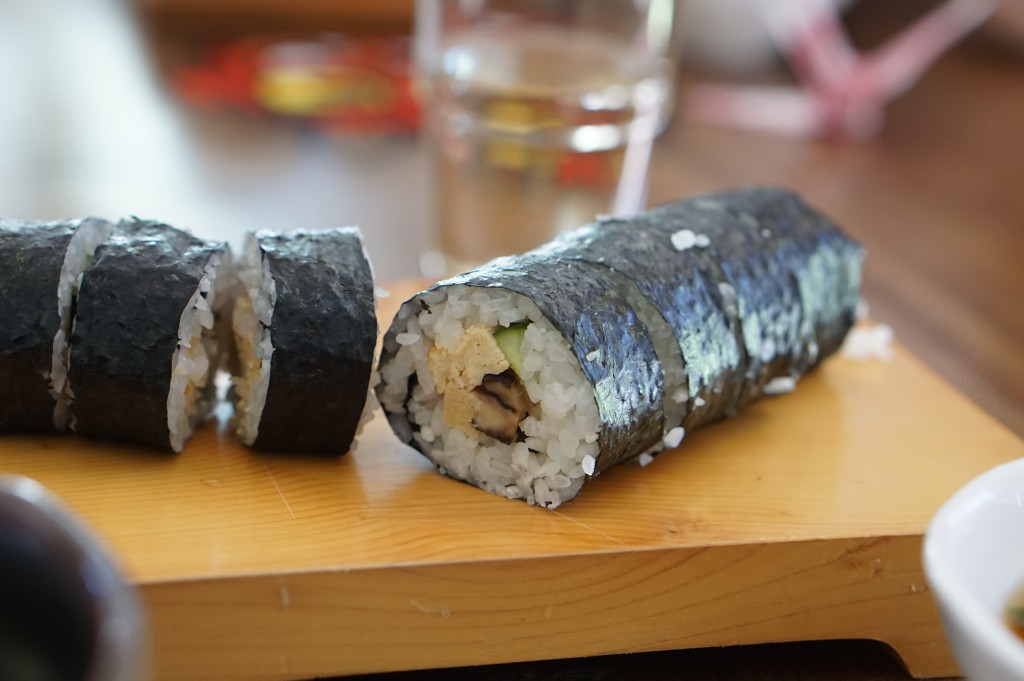
Happy New Year everyone. One month has already passed and now it’s time to celebrate Chinese New Year!
I’m excited to introduce you to the Japanese tradition of Setsubun, which is related to the Chinese New Year. We celebrate it on the same date every year, February 3rd.
Our custom is to eat Ehoumaki, which is a long sushi roll, on the night of Setsubun. While eating our Ehoumaki we must be silent and face the year’s “lucky” direction with our eyes closed, wishing for perfect health in the year ahead.
This year, the lucky direction is south-west. The Ehoumaki itself cannot be cut into smaller pieces and must be eaten long, otherwise the connection with other people will be broken. You must also remain silent while eating it, otherwise, we say, the happiness will be gone.
Our tradition of Setsuban might sound funny to you .. Eating Ehoumaki, a long sushi roll that cannot be broken or cut, silently and with our eyes closed, all the while facing in the lucky direction … I know, because it always seemed funny to me as a little girl and doing it always seemed even more funny. My mum always said to me when I was a little, ‘Be quiet’, ‘ Don’t laugh’, and, ‘Make a wish’ … Yes, this is our tradition.
Ehoumaki, is made with seven ingredients. The seven ingredients represent the seven gods of fortune, called, “Shichifukujin”. The seven ingredients can be anything, but the following recipe is commonly used, though many people like to use seafood or even make it vegetarian.
I know you guys have tried many sushi rolls such as dragon rolls, seafood sushi rolls, or teriyaki chicken rolls, however, Ehoumaki is completely different to them. I think it is a Japanese tradition worth knowing!
So, let’s make Ehoumaki! (*Ingredients are at the bottom)
First, rehydrate some dried food such as Kanpyo (dried gourd), or dried shiitake mushrooms.
Next, prepare sushi rice. Place the ingredients for the sushi vinegar in a small pan, and boil for 1 minute. Wash the rice the let it sit for 30 minutes in a strainer.
Put the rice, sake, and konbu seaweed in a rice cooker, add the amount of water for sushi rice. When the rice is cooked, remove the konbu and let the rice sit for 10 minutes. Transfer the rice in a big bowl, add the vinegar dressing, and mix thoroughly. While mixing, use a fan to cool down the rice.
As one of the possible 7 ingredients for Ehoumki, I’m excited to share with you how to make Tamagoyaki.
First, break the egg(s) and whisk together with ingredients listed for making tamagoyaki. Lightly coat a warm pan with vegetable oil, spread out 1/4 of the egg mixture, when the edges are cooked, roll up. Repeat until egg mixture is gone. Cut the tamagoyaki into narrow strips.
Shiitake mushrooms and Kanpyo
Slice the shiitake thinly, add it to a small pot along with the kanpyo, water used for rehydrating the shiitake, sake, sugar, and soy sauce. Boil. Cut them into narrow strips.
Koya-tofu
Rehydrate in water, then squeeze firmly with both hands to remove the water. Slice in half lengthwise, and cut the length into fourths, cutting into strips. Place the koya tofu in a pot along with all the other ingredients listed for ‘Simmered Koya Tofu’ and partially cover. Simmer for 10 minutes. Squeeze out the water from the koya tofu. Cut it into narrow strips.
Cucumber
Sprinkle a cucumber with salt to draw out moisture before squeezing it dry and cutting it into thin pieces, lengthwise.
kamaboko
Just cut it into narrow strips.
Sakura Denbu (Sakura denbu is a sweet-salty, fluffy pink flaked fish condiment. )
Finally, after preparing all ingredients, it’s time to roll up!
Place with 1/2 cup of the sushi rice. Spread out the rice, leaving a 3 cm gap at the top. On the spread out rice, centre the fillers. Gently press and roll up, rolling up the fillers. Adjust the shape pressing from the top
Traditional activity, bean throwing called mamemaki, is done at home on the night of Setsubun. People scatter roasted soy beans inside and outside their houses shouting, “Fortune in, devils out”.
Then they eat the same number of beans as their age and wish for good health. Bean is “mame” in Japanese which means good health.
At some houses, where there are especially young children, one of the family members (usually the father) act as an “Oni”, and the kids throw beans at him to make him ran away.
INGREDIENTS / 4 SERVINGS
Nori sheets …………………. 4
For dried shiitake
and kanpyo:
Shiitake mushrooms …… 4
kampyo (dried gourd) …. 4
Water for rehydrating ….. 200ml
Sake …………………………… 4 Tbs
Sugar …………………………. 4 Tbs
Soy sauce …………………… 1 Tbs
For Koya tofu:
Koya tofu ……………………. 3
Dashi stock …………………. 100ml
Sake …………………………… 1Tbs
Sugar …………………………. 1Tbs
Usukuchi soy sauce …….. 1Tsp
pinchSalt ……………………. 1
For Dashimaki tamago:
Eggs …………………………… 4
Dashi plus soy source and sugar
For green:
Cucumber ………………….. 1
Salt
2 other ingredients:
kamaboko
Sakura Denbu (Sakura denbu is a sweet-salty, fluffy pink flaked fish condiment. )
For Sushi rice:
White rice …………………… 1kg
Kombu
Sake …………………………… 1tbs
For sushi vinegar:
Vinegar ………………………. 100ml
Sugar …………………………. 6tbs
Salt ……………………………. 1tsp
If you want to buy all ingredients to make Ehoumaki and enjoy Mamemaki, the place to go is Tokyo Mart in North Bridge.
Address: Shop 27/79-113 Sailors Bay Road, Northbridge NSW 2063
We were so great to have Washoku Lovers to cook Ehoumaki together on the last weekend. New post, about Washoku Lovers Kitchen, is coming very soon!